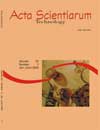<b>Optimal control in fed-batch reactor for the cellobiose hydrolysis</b> - DOI: 10.4025/actascitechnol.v25i1.2236
DOI:
https://doi.org/10.4025/actascitechnol.v25i1.2236Keywords:
controle ótimo, reator batelada alimentada, otimização, celobiose, princípio máximo de Pontryagin, inibição enzimáticaAbstract
Glucose can be obtained from cellulose through enzymatic hydrolysis by the enzymes of the celullase complex. Cellobiose hydrolysis by cellobiase exhibits substrate and product inhibition, which reduces the reaction's performance. The researches available in the literature on this subject were made in batch reactors; a study concerning the possibility on the use of another type of reactor has not yet been made. The aim of this work is to analyze the use of a fed-batch reactor to this enzymatic reaction. Feed policy was determined using the optimal control theory, where substrate conversion and final product concentration were maximized. Simulated results were compared with experimental data obtained by Calsavara et al. (1999) in a batch reactor and indicated that substrate inhibition overcomes product inhibition. The fed-batch operation was advantageous in some situations.Downloads
Download data is not yet available.
Downloads
Published
2008-04-15
How to Cite
Corazza, F. de C., Moraes, F. F. de, Zanin, G. M., & Neitzel, I. (2008). <b>Optimal control in fed-batch reactor for the cellobiose hydrolysis</b> - DOI: 10.4025/actascitechnol.v25i1.2236. Acta Scientiarum. Technology, 25(1), 33–38. https://doi.org/10.4025/actascitechnol.v25i1.2236
Issue
Section
Chemical Engineering
License
DECLARATION OF ORIGINALITY AND COPYRIGHTS
I Declare that current article is original and has not been submitted for publication, in part or in whole, to any other national or international journal.
The copyrights belong exclusively to the authors. Published content is licensed under Creative Commons Attribution 4.0 (CC BY 4.0) guidelines, which allows sharing (copy and distribution of the material in any medium or format) and adaptation (remix, transform, and build upon the material) for any purpose, even commercially, under the terms of attribution.
Read this link for further information on how to use CC BY 4.0 properly.











8.png)




